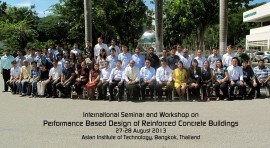
On 27-28 August 2013, the Asian Center for Engineering Computations and Software (ACECOMS) in collaboration with AIT Consulting, organized a seminar and workshop on the Performance Based Design of Reinforced Concrete Buildings at the AIT Hotel and Conference Center, Asian Institute of Technology, Bangkok, Thailand.
The seminar welcomed over sixty participants from the Philippines, Myanmar, Thailand, Brunei, and Hong Kong, ranging from practitioners with diverse backgrounds, and students from AIT.
The two-day seminar and workshop provided the necessary background and hands-on demonstration of performance based design of concrete buildings. Performance Based Approaches (PBA) have gained considerable acceptance in the recent years for determining and designing structures for specific hazards, especially earthquakes. PBA provides a rational and systematic way for determining the performance of structures using relatively rigorous techniques and tools, including the effects of non-linearity and dynamics to achieve specific response targets.
The first day of the seminar commenced with an overview on Performance Based Design (PBD) by Dr. Naveed Anwar, Executive Director, AIT Consulting. Dr. Anwar elaborated on the objectives, criteria, and outcomes of PBD, listing some specific examples and focusing on how PBD can be used to withstand the effect of earthquakes. Dr. Anwar followed with a lecture on Modeling for Pushover and Nonlinear Dynamic Analysis beginning with answering why Nonlinear Analysis is needed and defining Nonlinearity. He provided detailed explanations of modeling nonlinearity in materials, modeling nonlinearity in sections, and modeling for of members, and ended with the detailed concept of the P-Delta Effects. The second half of the day featured two hands-on training workshops on nonlinear modeling concepts and procedures in SAP2000 and modeling for PBD in PERFORM 3D by Mr. Thaung Htut Aung and Mr. Shabir Talpur, respectively.
The second day of the seminar included two morning lectures covering capacity based design of structural components and site-specific seismic hazard assessment. Dr. Anwar centered on the general concepts of capacity design approach and provided detailed explanations on how capacity design can be used to control behavior. Dr. Teraphan Ornthammarath, Scientist, Seismic Risk Evaluation and Mitigation Regional Integrated Multi-Hazard Early Warning, System for Africa and Asia (RIMES) focused on the various components and process for Probabilistic Seismic Hazard Assessment (PSHA) in relation to an actual project conducted for Metro Manila, an area in the Philippines with high seismic activity. In the afternoon session, Dr. Pennung Warnitchai, Associate Professor, Structural Engineering, School of Engineering and Technology, AIT expounded on wind effects on buildings, tall chimneys, stacks, observatory towers, and other structures. He provided visuals showing the devastating effects of differing ground motions and strong winds all over the world, and ended off with an illustration of how and why wind tunnel model tests can be conducted for various types of structures. The final session was a workshop on PBD of core wall building by Mr. Thaung Htut Aung highlighting topics on material properties, loading criteria, performance evaluation criteria, finite element modeling, and nonlinear modeling of shear wall and coupling beams.
The seminar and workshop adjourned with a certificate and token-giving ceremony.

